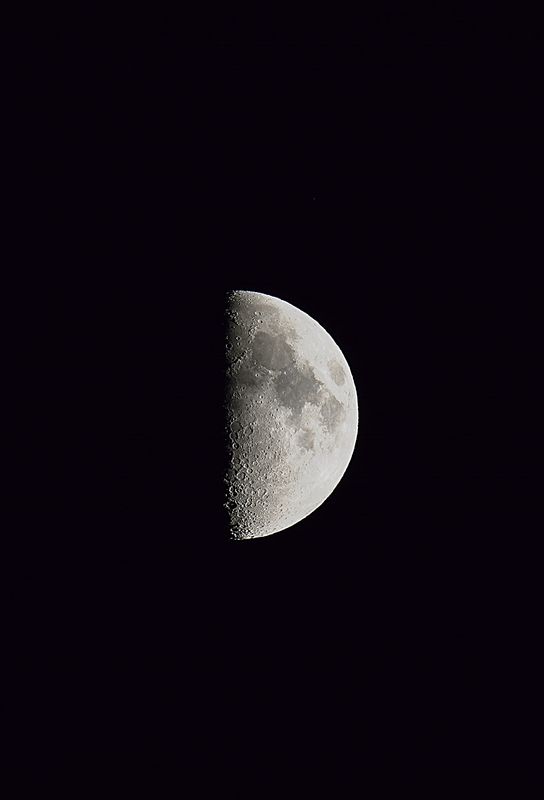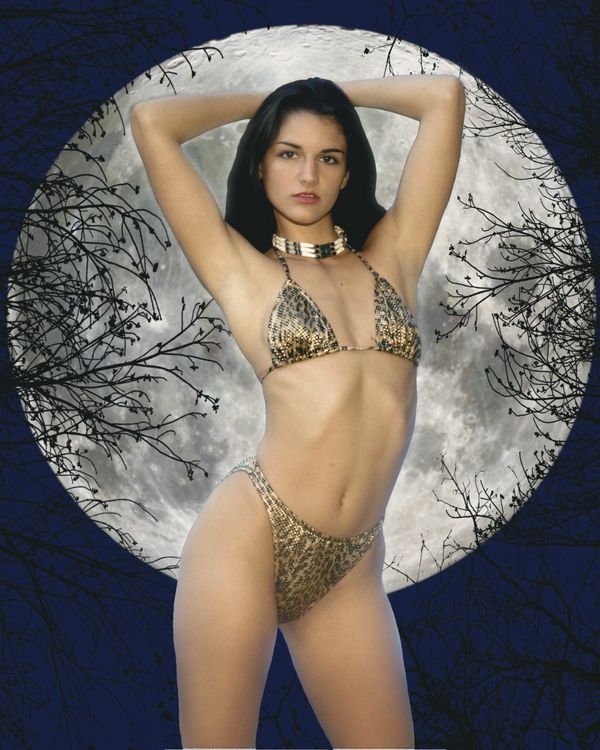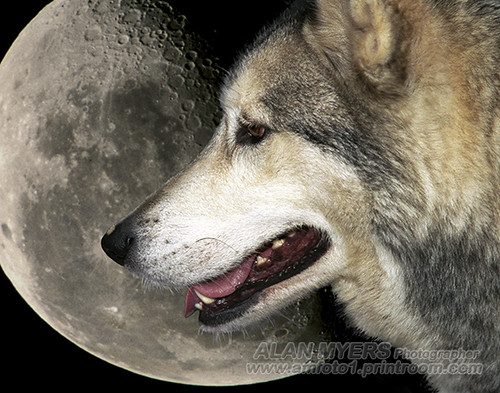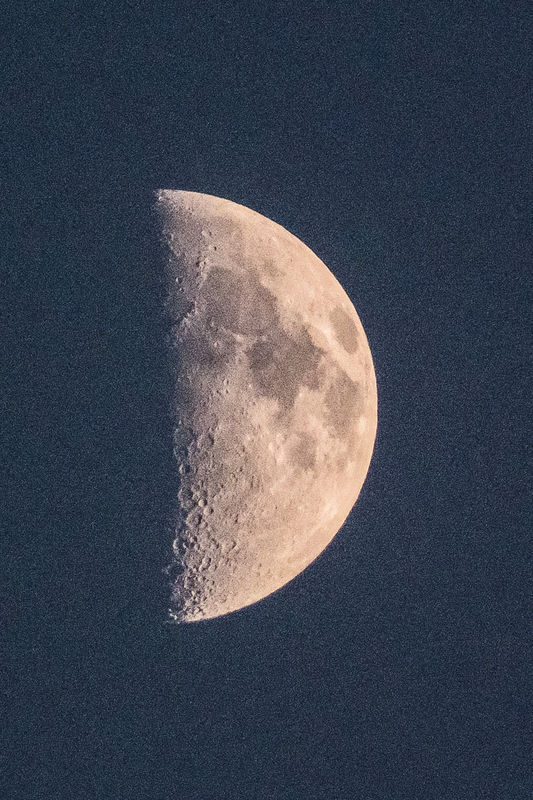Moon photo tips
Aug 4, 2014 10:14:21 #
I think all the parameters mentioned for SS F-stop and ISO have worked for me at one time or another.
When I first looked at the exif data on my first moon photos I thought..."what the hell?"...they kind of go against your instinct.
ISO 125...SS 1/160...F 6.5 Canon sx50
Another good point...is shooting a full moon is the most difficult...try waxing or waning for greater detail.
When I first looked at the exif data on my first moon photos I thought..."what the hell?"...they kind of go against your instinct.
ISO 125...SS 1/160...F 6.5 Canon sx50
Another good point...is shooting a full moon is the most difficult...try waxing or waning for greater detail.

Aug 4, 2014 10:46:47 #
Jim Peters wrote:
First Check The Area That You Are Working At.Make Sure There Are No Young Girls In Bikinis Around. They Will Jump In Front Of Your Camera In An Instant. Blocking Out That Great Moon Shot!
I see what you mean - really spoilt that shot - but can we have a download anyway?
Aug 4, 2014 11:28:59 #
MacroChick wrote:
Any one have any tips on getting good moon photos with a camera (no telescope)?
My biggest issue is that they still look a little too exposed no matter the shutter speed I pick.
I am using ISO 100, F22 and have tried differing shudder speeds and exposure adjustments. am wondering if maybe a filter would help get more details.
Any suggestions?
I do not have any examples, cause I deleted all my attempts, and have not tried again recently.
My biggest issue is that they still look a little too exposed no matter the shutter speed I pick.
I am using ISO 100, F22 and have tried differing shudder speeds and exposure adjustments. am wondering if maybe a filter would help get more details.
Any suggestions?
I do not have any examples, cause I deleted all my attempts, and have not tried again recently.
I would suggest spot metering just on the moon. If you meter on the whole scene with the dark background around the moon you will get an image with the moon burned out and no detail. :thumbup:
Aug 4, 2014 11:41:34 #
lighthouse wrote:
No filters.
Use F/8.
100 ISO.
1/200th sec as a starting point.
Careful not to overexpose.
Main thing people get wrong with moon photos is shooting them too bright.
For a full moon shot, be prepared to darken and push contrast in post work to get better moon detail.
Use F/8.
100 ISO.
1/200th sec as a starting point.
Careful not to overexpose.
Main thing people get wrong with moon photos is shooting them too bright.
For a full moon shot, be prepared to darken and push contrast in post work to get better moon detail.
Good advice.
Atmospheric conditions play a big role as well. Make sure its a very clear night.

Aug 4, 2014 11:58:26 #
joer wrote:
Good advice.
Atmospheric conditions play a big role as well. Make sure its a very clear night.
Atmospheric conditions play a big role as well. Make sure its a very clear night.
Nice...
Aug 4, 2014 12:23:41 #
mjbrock2012
Loc: Grants Pass,Oregon
here's a red moon from last nite. I braced the SX50 against the door jam and let the camera decide on everything
Aug 4, 2014 12:24:41 #
Aug 4, 2014 12:37:20 #
Aug 4, 2014 13:38:40 #
Gene51 wrote:
Use 1/ISO for your shutter speed, and anywhere fro... (show quote)
+++++++++++++
YES!!!! One Hundred (100) ISO.....
Great image capture of the "Orb".... I too agree with the capturing of the moon at ANYTHING than FULL Phase.... You can and WILL get best detail....
The Moon reflects about 250 "light candles per square foot"
and it is reflected light... Expose accordingly.
:-)
Aug 4, 2014 14:31:35 #
James R wrote:
+++++++++++++
YES!!!! One Hundred (100) ISO.....
Great image capture of the "Orb".... I too agree with the capturing of the moon at ANYTHING than FULL Phase.... You can and WILL get best detail....
The Moon reflects about 250 "light candles per square foot"
and it is reflected light... Expose accordingly.
:-)
YES!!!! One Hundred (100) ISO.....
Great image capture of the "Orb".... I too agree with the capturing of the moon at ANYTHING than FULL Phase.... You can and WILL get best detail....
The Moon reflects about 250 "light candles per square foot"
and it is reflected light... Expose accordingly.
:-)
Thanks, James. On this night she was cooperative and showed me her good side. :)
Aug 4, 2014 14:38:43 #
Delderby wrote:
Sure,Why not!I see what you mean - really spoilt that shot - but can we have a download anyway?

Aug 4, 2014 14:53:23 #
amfoto1
Loc: San Jose, Calif. USA
Some things not yet mentioned, or only mentioned briefly...
The moon moves much faster than we realize. You need a fairly fast shutter speed or you'll get motion blur. I'd recommend no less than 1/100.
As everyone has noted above, it's also brighter than most people realize. Set your camera to manual exposure, since it's likely any auto exposure will be overly influenced by the dark around the moon. As noted, the moon is simply reflecting sunlight. As such, it's about one stop less light than "daytime". So, starting from the "Sunny 16 rule" that says in broad daylight, a correct exposure will be f16 and a shutter (or "shudder") speed that's the reciprocal of the ISO you've chosen.
So to get 1/100 shutter speed, Sunny 16 says you can set f16 aperture and ISO 100... But we need another stop (approx.) open up the aperture to f8 (rather than going to a slower shutter speed).
What's really difficult is trying to make a scenic night shot that includes the moon... the dynamic range of from the bright moon to softly moonlight scene is way, way beyond the capabilities of most film and sensors. One thing you can is to combine two images. There is no way I could have made this shot in a single exposure....

For the above, the wolf was photographed with a 28-135mm lens and film camera and a flash, while the moon was shot digitally with a 500mm lens, 2X teleconverter and a Canon 10D DSLR (effective "full frame" equivalent focal length: 1600mm) on a very steady tripod. This was because of the very different exposure needs, plus there really was no way to capture both in a single image because of the wildly different distances to subject.
Alternatively, some sort of partial filtering and/or post-process dodging and burning of the image might be used. I guarantee you that Ansel Adams used some form of partial filtration and/or heavy dodging and burning to make a print of his "Moonrise Over Hernandez New Mexico" image (http://nikosono.files.wordpress.com/2010/07/ansel-adams-moonrise-hernandez-new-mexico1941.jpg)
Another "trick" is to shoot at dusk or pre-dawn, when the sky isn't fully dark yet and the foreground is still somewhat illuminated. If you want the moon to be against a dark sky, you can darken it and remove color in post-processing.
There are times when the moon is closer or further from the earth, when it can appear around 15% larger or smaller.
And, if the atmosphere is very clear, it can help to shoot the moon while it's low on the horizon. Shooting through more atmosphere has a sort of magnifying effect. You've probably noticed how large the moon looks when it's very low on the horizon.
These last three require some planning (and luck, for a clear evening). There are various moon calendars online, which have to be related to your particular location.
Wouldn't that be more of a "moon shot", if the model were facing the other way? ;)
The moon moves much faster than we realize. You need a fairly fast shutter speed or you'll get motion blur. I'd recommend no less than 1/100.
As everyone has noted above, it's also brighter than most people realize. Set your camera to manual exposure, since it's likely any auto exposure will be overly influenced by the dark around the moon. As noted, the moon is simply reflecting sunlight. As such, it's about one stop less light than "daytime". So, starting from the "Sunny 16 rule" that says in broad daylight, a correct exposure will be f16 and a shutter (or "shudder") speed that's the reciprocal of the ISO you've chosen.
So to get 1/100 shutter speed, Sunny 16 says you can set f16 aperture and ISO 100... But we need another stop (approx.) open up the aperture to f8 (rather than going to a slower shutter speed).
What's really difficult is trying to make a scenic night shot that includes the moon... the dynamic range of from the bright moon to softly moonlight scene is way, way beyond the capabilities of most film and sensors. One thing you can is to combine two images. There is no way I could have made this shot in a single exposure....

For the above, the wolf was photographed with a 28-135mm lens and film camera and a flash, while the moon was shot digitally with a 500mm lens, 2X teleconverter and a Canon 10D DSLR (effective "full frame" equivalent focal length: 1600mm) on a very steady tripod. This was because of the very different exposure needs, plus there really was no way to capture both in a single image because of the wildly different distances to subject.
Alternatively, some sort of partial filtering and/or post-process dodging and burning of the image might be used. I guarantee you that Ansel Adams used some form of partial filtration and/or heavy dodging and burning to make a print of his "Moonrise Over Hernandez New Mexico" image (http://nikosono.files.wordpress.com/2010/07/ansel-adams-moonrise-hernandez-new-mexico1941.jpg)
Another "trick" is to shoot at dusk or pre-dawn, when the sky isn't fully dark yet and the foreground is still somewhat illuminated. If you want the moon to be against a dark sky, you can darken it and remove color in post-processing.
There are times when the moon is closer or further from the earth, when it can appear around 15% larger or smaller.
And, if the atmosphere is very clear, it can help to shoot the moon while it's low on the horizon. Shooting through more atmosphere has a sort of magnifying effect. You've probably noticed how large the moon looks when it's very low on the horizon.
These last three require some planning (and luck, for a clear evening). There are various moon calendars online, which have to be related to your particular location.
Jim Peters wrote:
Sure,Why not!
Wouldn't that be more of a "moon shot", if the model were facing the other way? ;)
Aug 4, 2014 16:43:43 #
here is one from the other day. It was about half an hour before sunset and the sky was a misty blue. I think the ISO was a bit too high and this caused grain in the darker areas. The camera was my HS50EXR with quite a small sensor (1/2.0")
F7.1 @ 1/400sec and iSO 800. Focal length 1000mm

Aug 4, 2014 17:53:35 #
Keep the aperture on the large side (f/4-5.6-8) to avoid image quality loss due to diffraction. Crop sensors are more susceptible to diffraction.
Also a fast shutter speed tends to minimize shutter slap and movement blur (moon and camera).
Also a fast shutter speed tends to minimize shutter slap and movement blur (moon and camera).
Aug 4, 2014 18:03:42 #
lighthouse
Loc: No Fixed Abode
joer wrote:
Keep the aperture on the large side (f/4-5.6-8) to avoid image quality loss due to diffraction. Crop sensors are more susceptible to diffraction.
Also a fast shutter speed tends to minimize shutter slap and movement blur (moon and camera).
Also a fast shutter speed tends to minimize shutter slap and movement blur (moon and camera).
An F/4 lens will be sharper at F/8 than it will be at F/4.
If you want to reply, then register here. Registration is free and your account is created instantly, so you can post right away.








